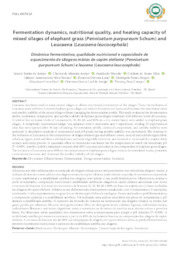Fermentation dynamics, nutritional quality, and heating capacity of mixed silages of elephant grass (Pennisetum purpureum Schum) and Leucaena (Leucaena leucocephala).
Fermentation dynamics, nutritional quality, and heating capacity of mixed silages of elephant grass (Pennisetum purpureum Schum) and Leucaena (Leucaena leucocephala).
Author(s): ARAÚJO, J. S. de; ARAÚJO, C. de A.; MACEDO, A.; SILVA, C. de S.; NOVAES, J. J. da S.; LIMA, D. O.; BORGES, E. N.; GOIS, G. C.; ARAUJO, G. G. L. de; CAMPOS, F. S.
Summary: Leucaena has been used to make mixed silages to obtain nutritional enrichment of the silages. Thus, the inclusion of Leucaena as an additive in mixed elephant grass silages can reduce fermentation losses, and increase the nutritional value and aerobic stability of the mixed silage without changing the fermentation profile. This study evaluated the fermentation profile, nutritional composition, and aerobic stability of elephant grass silages combined with different levels of Leucaena. A total of five inclusion levels of Leucaena (0, 20, 40, 60, and 80% on a dry matter basis) were added to elephant grass silages. A completely randomized design was adopted, with 5 treatments and 3 repetitions, totaling 15 experimental silos that were opened after 30 days of sealing. Fermentation profile, chemical composition, and aerobic stability were analyzed. A descriptive analysis of temperature and pH peaks during aerobic stability was performed. The increase in the inclusion of Leucaena in the composition of silages reduced gas and effluent losses, neutral and acid detergent fiber, cellulose, lignin, total and fiber carbohydrates, and total digestible nutrients, and resulted in increased dry matter, ether extract, and crude protein. A quadratic effect of treatments was found for the temperature to reach the maximum pH (P=0.009). Aerobic stability remained constant after 40% Leucaena inclusion in the composition of elephant grass silages. The inclusion of Leucaena up to 80% in the composition of elephant grass silages reduces fermentation losses, promotes a nutritional increase, and increases the aerobic stability of the silages.
Publication year: 2022
Types of publication: Journal article
Unit: Embrapa Semi-arid Region
Observation
Some of Embrapa's publications are published as ePub files. To read them, use or download one of the following free software options to your computer or mobile device. Android: Google Play Books; IOS: iBooks; Windows and Linux: Calibre.
Access other publications
Access the Agricultural Research Database (BDPA) to consult Embrapa's full library collection and records.
Visit Embrapa Bookstore to purchase books and other publications sold by Embrapa.

